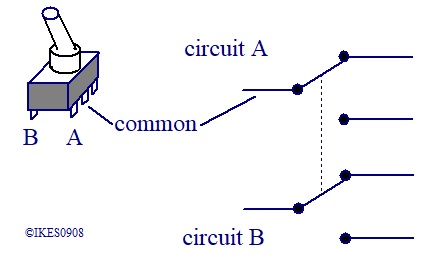
Switches
They all rely on the mechanical movement of pieces of metal to come into contact and so close an electrical circuit,
or separate, to break a circuit.
Switches with contacts that close to make a circuit are known as Normally Open or NO.
Switches with contacts that are normally closed and open to break a circuit are known as Normally Closed or NC.
With switches, the change in resistance is dramatic, from almost zero ohms when the contacts are closed
to almost infinite resistance when the contacts are open.
The most readily identifiable switch is the "Toggle Switch".
It is often used as an On/Off switch in electrical equipment.
It is also used to operate most lighting circuits both in the home and in the work / educational place.
A diagram of a toggle switch is shown below.

The lever is spring loaded so that as soon as the switch starts to operate, the spring helps complete the operation quickly
to minimise any sparks between the contacts that may form as the circuit is made or broken.
The switch shown above can only control one circuit and so is known as a Single Pole, Single Throw (SPST) switch.
Toggle switches are also available that can switch between two circuits as shown in the diagram below.

it can be used to switch between two different circuits.

The "Pole" referring to the fact that there are two separate switches, both controlled by the same lever.
Two completely separate circuits can be switched at the same time with this switch.
A switch combining all of these features together is Double Pole, Double Throw (DPDT) switch.
It is two completely separate change over switches operated by the same lever, as in the diagram below.

It can be used to switch from "forwards" to "reverse" on a model train set.
The circuit diagram of such a reversing switch is shown below.


Small DPDT toggle switch

Big SPDT toggle switch
Toggle switches tend to be expensive and extend beyond the enclosure of the electronic system.
A cheaper and smaller alternative is to use "Slide switches", though they can be less robust than toggle switches.
Both of the photographs opposite show DPDT slide switches.

Small DPDT slide switch

Large SPDT toggle switch
Sometimes a switch is required that operates with a much smaller movement than a toggle switch,
e.g. the safety switch on a microwave cooker, which switches off the power if the door is opened.
Such switches are known as microswitches.
The 'micro' refers to the movement needed to operate the switch, not to its physical dimensions.
The current carrying/switching capacity can often be as high as 15A.
A diagram of a microswitch is shown below and photographs opposite.

They can also be used on remote control buggies and robots as 'collision' detectors.

A micro switch.

A lever micro switch.

A roller lever micro switch.
A 'tilt switch', as its name implies, will operate when tilted, and so can be used in anti theft devices.
Original tilt switches consisted of two metal electrodes encapsulated in plastic along with a small amount of mercury,
as shown in the diagram below.

the circuit between the electrodes.
When tilted in the opposite direction, the mercury flows to the opposite end and so breaks the circuit.
For safety reasons, most tilt switches now have a small metal ball instead of the mercury.

A mercury tilt switch.
Another useful switch is one that operates in the presence of a magnetic field.
Such switches are known as 'Reed Switches' and are often used in burglar alarm systems to detect when a door is open or closed.
A reed switch is shown in the diagram below.

The pieces of steel are magnetised so that they repel each other and so keeping the contacts apart.
When a strong magnetic field is placed near to the reed switch, this external magnetic field induces
an opposite magnetic field which causes the contacts to close.
As soon as the external field is removed, the contacts open again.
Although most reed switches are SPST types, it is possible to obtain SPDT types.
Reed switches are only suitable for switching small currents (<200mA).
But, as a result of the small movement of the contacts, they can switch quickly (a few hundred Hertz).

A reed switch.